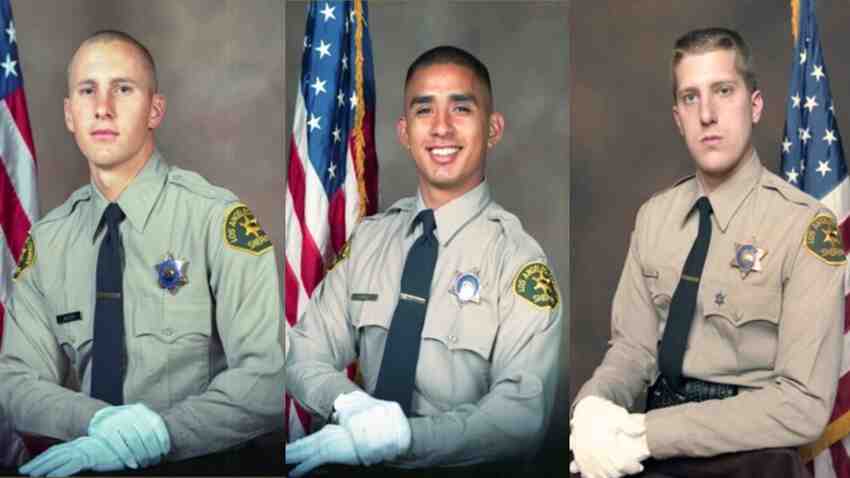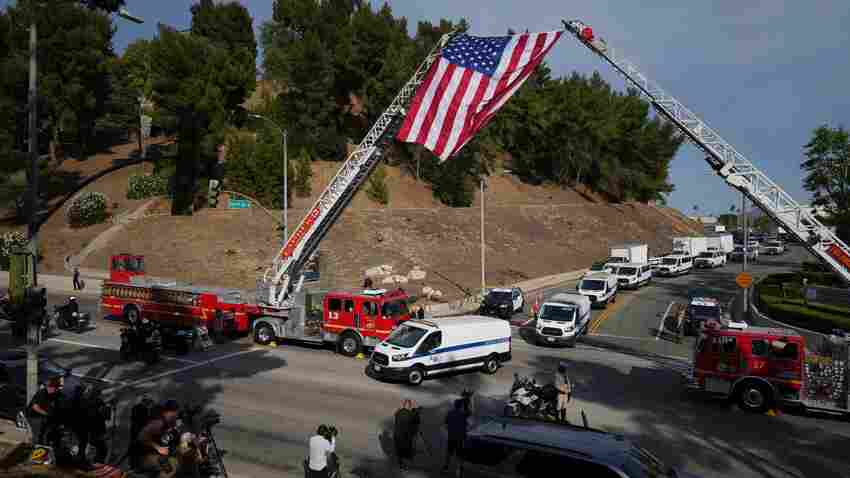A Morning Like Any Other Until It Wasn’t
LA Sheriff Training Explosion: On Friday, July 18, 2025, at roughly 7:30 a.m., the day began quietly at the Biscailuz Center Academy Training Facility in East Los Angeles—home to the Los Angeles County Sheriff’s Department’s elite arson and explosives team. Moments later, a violent explosion erupted in a parking lot packed with sheriff patrol cars and support vehicles, shattering the stillness—and forever altering lives.
Within minutes, local fire and bomb squads rushed to contain the scene. Deputies rushed to evacuate the area. But by then, three veteran detectives were dead: Joshua Kelley‑Eklund (19 years on the force), Victor Lemus (22 years), and William Osborn (33 years)—a collective 74 years of service lost in a single, inexplicable tragedy.
Sheriff Robert Luna later called it the deadliest single incident for LASD since 1857, when several deputies were killed in an ambush.
Who Were the Fallen? Heroes Defined by Service and Expertise
The three detectives sorted exclusively into the Arson & Explosives Detail, part of LASD’s Special Enforcement Bureau—a small group trained for high‑risk responses to explosive threats.
Sheriff Luna described them as “fantastic experts,” who responded to more than 1,000 explosive-related incidents per year. Their combined service—nearly three-quarters of a century—reflects unmatched dedication.
At the scene, a procession formed later that day. In silence, uniformed officers stood in formation as the bodies were escorted to the coroner’s van. Deputies saluted their comrades, honoring service and sacrifice amid broken grief.
LA Sheriff Training Explosion Initial Details: What We Know So Far
- Timing: Explosion occurred around 7:30 a.m. PT, in a parking zone with several patrol cars and equipment trucks nearby.
- Location: Biscailuz Training Facility, the LASD’s primary bomb‑handling and enforcement training center, opened in 2017 in East L.A..
- Victims: Detectives Kelley‑Eklund, Lemus, and Osborn, all part of the specialized enforcement team with long tenures.
- Scene safety: It took more than four hours to secure the site before investigators could enter, due to lingering hazards.
- Cause: Still unclear. Investigators are examining whether this was a training accident—possibly involving an unexploded device transported from a Santa Monica apartment discovered the prior day. Connections remain unconfirmed.
LA Sheriff Training Explosion Explosive Link: A Santa Monica Lead
Law enforcement sources revealed that the bomb squad had recently responded to a Santa Monica storage unit where construction workers unearthed grenades in a former tenant’s locker. The deputies involved in that call may have been transporting one such device to the training facility when it detonated.
Investigators—including homicide units, ATF, FBI, LAPD bomb squad, and State Fire Marshal—are interviewing witnesses and exploring whether the device was mishandled, unstable, or otherwise dangerous.
Grief and Solidarity: Officials Speak Out
Sheriff Luna, at a press conference, said:
“There’s a lot more that we don’t know than what we do know… Our intent is to look at this from the very beginning and figure out exactly what caused this tragic event.”
He invoked deep sorrow, especially during conversations with the deputies’ families:
“I have met with two of the three families thus far. Those were extremely challenging conversations,” Luna confessed, voice breaking.
Attorney General Pam Bondi posted on social media:
“This appears to be a horrific incident… Our federal agents are at the scene and we are working to learn more. Please pray for the families…”
Mayor Karen Bass and Governor Gavin Newsom offered the state’s full cooperation and expressed sorrow over the department’s deepest loss since the mid‑19th century.
U.S. Rep. Judy Chu and Sen. Adam Schiff shared condolences via social platforms, calling for answers and justice for the deceased deputies.
Why This Matters: Training as Hidden Danger
Law enforcement tragedies often occur on the streets—but this one happened behind closed gates, in a routine training context. That magnifies the pain.
Many training centers across the country still rely on aging infrastructure and outdated safety protocols—especially for volatile materials. In recent years, multiple departments have reported injuries from live‑scenario drills gone wrong.
This incident raises urgent questions—not just for LASD, but for departments nationwide:
- Were proper protocols followed in moving and handling explosive devices?
- Were deputies adequately supported with updated equipment?
- Are standard audits and safety drills sufficient?
- How will oversight evolve to prevent another tragedy in a training context?
LA Sheriff Training Explosion What Comes Next: The Road Ahead
🔍 Multi‑Agency Investigation Underway
Homicide detectives are leading the probe, supported by federal agents from the FBI and the Bureau of Alcohol, Tobacco, Firearms & Explosives, with assistance from local bomb squads and arson investigators.
⚖️ Criminal Liability or Negligence?
If investigations point to mishandled ordinance or negligence, legal consequences may follow. But findings may also expose gaps in training programs or department oversight.
🧠 LA Sheriff Training Explosion: Morale and Recovery
LASD is providing mental health support services to all who responded or survived the scene. The emotional weight of losing three longtime colleagues in a moment meant for preparedness cannot be underestimated.
🔁 Training Suspensions & Reforms on the Way
The Special Enforcement Bureau has paused all explosive-related training until a thorough safety review is completed. Facility audits and procedural revisions are expected department-wide.
🕯️ Respecting the Fallen: Public Grief and Honor
Angelenos responded quickly:
- Candlelight vigils were held outside the Biscailuz Center and across East L.A.
- The hashtag #LASheriffStrong trended on social platforms as a symbol of solidarity.
- Flags flew at half‑mast across county buildings.
A community procession escorted the departed in silence—a reminder of both service and loss—and underscored how deeply the tragedy cut into the public consciousness.
Fallen Heroes: Faces Behind the Uniform
Detective William Osborn – 33 Years of Service
William began his law enforcement journey in 1992. He later became a respected instructor at the department’s emergency vehicle training unit before returning to investigations. In 2019, he joined the elite bomb squad, serving as a go-to expert for complex operations. Colleagues remember him as calm under pressure, forever eager to share his deep expertise.
Detective Victor Lemus – 22 Years, Heart of a Mentor
Victor’s career began in 2003, transitioning from base-level duties to the K-9 unit, where he thrived. He recently became part of the Arson & Explosives team. Known as a mentor and team builder, he earned multiple commendations for training deputies and leading high-risk arrests. His loss has left a gap in leadership and kindness within the unit.
Detective Joshua Kelley‑Eklund – 19 Years with a Purpose
Joshua brought compassion and dedication from day one. Starting as a corrections officer, he moved through narcotics, serving as a field training officer and detective before joining the bomb squad in 2022. He had seven children and was the newest member of the detail—but already made a mark as a caring, driven officer.
Between them, these three deputies dedicated a combined 74 years of service, the embodiment of experience, bravery, and mentorship.
Impact on LAPD, LASD, & Across the Nation
Their passing isn’t just a local tragedy—it sparked heartfelt tributes nationwide:

- Law enforcement solidarity: LAPD, SWAT, fire, and bomb squads lined up to support LASD—officers gathered in solemn procession across department lines.
- First responders & media: Local neighbors spoke of hearing the blast like “a small earthquake.” K-9 teams, dispatchers, and media crews rallied to ensure the victims were honored and remembered.
- Public surge of grief: Moments after the explosion, flags flew at half-mast across Los Angeles County. Community vigils lit up East L.A.; donations poured in through deputy support funds.
LA Sheriff Training Explosion Early Line of Investigation: A Grenade from Santa Monica?
Investigators quickly turned their attention to a storage locker in Santa Monica, where military-style grenades were discovered the day before. Deputies reportedly moved one such device to the Biscailuz facility—believed inert—when it exploded.
A federal task force now leads the inquiry, including LAPD Bomb Squad, ATF, FBI, and State Fire Marshals. This multi-agency involvement shows the seriousness and potential legal implications surrounding the incident—whether accidental or due to negligence.
Safety Breakdown: How a Training Facility Became a Deathtrap
The incident raises deep questions about departmental safety:
- Aging equipment and evolving threats: Even though the Biscailuz Center was refurbished in 2017, bomb technicians frequently work with relic ordnance dating back decades—some unmarked, unpredictable, and unstable.
- Protocol gaps: Was the device properly cleared? Were operating procedures robust enough—especially outside live incident zones?
- Mental health toll: LASD has faced multiple tragedies recently, including a spike in deputy suicides. Adding violent training deaths to this pressure could strain mental resilience within the force.
Training centers nationwide depend on rigorous systems—but this tragedy shows even elite teams face vulnerabilities.
LA Sheriff Training Explosion: Reforms Already in Motion
In just days, the department and local leaders began enforcing changes:
- Immediate moratorium: All explosive-handling training halted until a full safety audit concludes.
- Multi-agency investigations: Homicide detectives and federal agents examine every handling stage.
- Policy review underway: County supervisors now require updated handling, transport, and storage protocols in training centers.
- Infrastructure upgrades: Departments are assessing equipment freshness, early-warning systems, and blast segregation safety measures.
- Mental health support: Counseling services and peer groups are being prioritized for impacted deputies and their families.
A Community United in Grief—and Purpose
The public response has been profound:
- Emotional outpouring: Hundreds attended candlelight vigils, leaving flowers, letters, toys, and uniform patches at the training grounds.
- Solidarity online: The hashtag #LASheriffStrong became a symbol of shared mourning and support.
- Mutual aid: The Association for L.A. Deputy Sheriffs quickly launched a fund for families facing funeral costs, education needs, and long-term hardship.
- Local collaboration: Faith leaders, business owners, and schools joined together to offer ongoing support for families left behind.
If you like this post we recommend you something similar:
What Happened: Explosion at Rome Petrol Station Injures at Least 27 People
LA Sheriff Training Explosion What the Future Must Hold
For real change, several key actions must follow:
- Mandatory third-party audits – Departments need independent safety reviews for bomb-handling procedures.
- Uniform nationwide protocols – Standardized training and transport rules across agencies would limit preventable errors.
- Training technology investment – Simulated ordnance devices and remote-release tactics could reduce fatalities during real transport.
- Clear accountability measures – Oversight bodies must track policy adherence and enforce compliance.
- Sustained mental health focus – From recruits to veterans, emotional resilience must be part of every officer’s toolkit.
Public awareness and support will be vital to ensure these measures aren’t just words—but real action.
LA Sheriff Training Explosion Honor the Fallen: Ways You Can Help
From the public to professionals, here’s how you can turn grief into action:
- Donate – Give directly to funds supporting the families.
- Attend vigils – Show solidarity with deputies and local responders.
- Share knowledge – Help raise awareness of training facility risks and needed reforms.
- Support policy – Urge elected officials to back safety reviews, infrastructure upgrades, and accountability measures.
Looking Ahead with Resolve
The Blast at Biscailuz Center is a stark lesson: even with expertise and safety protocols, tragedy can strike where we least expect. But from calamity can grow determination—and from mourning can come reform.
Honoring Detectives Osborn, Lemus, and Kelley‑Eklund means more than respectful words. It demands concrete safety improvements, community vigilance, and sustained mental health care for first responders.
They were not only deputies—they were leaders, mentors, and sons and fathers devoted to public service. Let their legacy be not just remembrance, but transformation.
A National Reckoning: Policy and Practice Under Scrutiny
The Biscailuz tragedy is more than a local sorrow—it’s a flashpoint for law enforcement training practices across the country. In major cities like New York, Chicago, and Houston, similar units operate bomb squads and arson divisions under complex, often inconsistent protocols. The East L.A. explosion highlights a widespread gap in regulation and oversight of these high-risk operations.
No Industry-Wide Standards on Handling Ordnance
Currently, there’s no single national standard dictating explosive-handling procedures for sheriff’s offices or municipal bomb squads. Many agencies rely on guidance from entities like the FBI’s Hazardous Devices School, but how—and whether—these guidelines translate into field-level protocols varies dramatically. As one retired major noted, variables like weather conditions, device age, and storage discrepancies can significantly affect outcome—and training centers often aren’t equipped to control all those variables.
A Risky Landscape: Historic Precedents Exposed
Dangerous training accidents aren’t new:
- In 2021, a botched fireworks-destruction drill near Los Angeles injured over a dozen civilians and damaged homes.
- In 2022, an FBI drill in Pennsylvania ended with five technicians injured when an inert device detonated unexpectedly.
These events reveal that high-stakes training, especially involving unstable materials, can go tragically sideways—even under official oversight.
Four Pillars of Reform: What Must Change Now
To prevent future tragedies, experts urge immediate action in four key areas:
1. Mandatory Safety Audits by Independent Experts
Every law enforcement agency should be required to host annual, third-party audits of its explosive-handling procedures and facilities. Internal reviews alone aren’t enough—external oversight ensures transparency and accountability.
2. Standardized National Protocols
Legislation should establish minimum safety requirements for:
- Transporting ordnance
- Storage and armory layouts
- Communication systems in training zones
- Emergency evacuation drills
If every bomb squad must meet identical safeguards, avoidable accidents become far less likely.
3. LA Sheriff Training Explosion: Adoption of Advanced Training Tools
Virtual simulation—robotics, VR/AR, and remote-controlled devices—can reduce exposure to live explosives. Such technology is already familiar in military training, yet rarely mandated for civilian law enforcement. The Biscailuz explosion proves why it’s time for modern investment.
4. Mental Health Integration in Operational Safety
Traumatic incidents impact more than physical safety. Departments must weave psychological support into training protocols—making debriefings, counseling, and peer networks standard after any live-device exercise or critical incident.
LA Sheriff Training Explosion From Tragedy to Policy: Who’s Responding
Following the explosion:
- County supervisors quickly demanded a top-to-bottom review of LASD training policies.
- State lawmakers pledged to author legislation mandating safety audits and uniform training standards statewide.
- Federal agencies, including the FBI, ATF, and DHS, are campaigning for grants to support modernization efforts for bomb squads nationwide.
- Civil rights groups and journalists are raising the profile of internal training hazards, urging journalists and watchdogs to maintain public attention and pressure.
This mobilization reflects widespread recognition that preventing similar tragedies requires systemic change—not occasional headlines.
LA Sheriff Training Explosion: How the Public Can Push for Change
Your voice matters. Here’s what individuals and communities can do:
- Contact elected officials: Speak to city council members, state legislators, and supervisors. Ask about training reforms, audits, and modernization funding.
- Engage with sheriff/supervisor meetings: Attend public sessions where training safety is discussed—especially if you’re a constituent.
- Support mental health initiatives: Advocate for wellness funds within sheriff’s budgets. Public servants deserve comprehensive care.
- Follow investigative coverage: Share and promote independent journalism examining training safety. Public awareness is often a catalyst for reform.
A Vision for the Future: Making the Lessons Count
This isn’t just about fixing systems—it’s about honoring lives:
- Detective Osborn, with three decades of veteran experience, showed us what leadership in service looks like.
- Detective Lemus, known for his mentoring spirit, taught us the importance of caring for colleagues.
- Detective Kelley‑Eklund, a devoted family man and newer team member, reminded us that every life—regardless of tenure—matters.
Their commitment should spark enduring change.
LA Sheriff Training Explosion What’s Next: Tracking Progress
In the coming weeks and months:
- Watch for audit reports from county and state officials, detailing new safety protocols.
- Follow legislative developments aimed at national training requirements.
- Monitor budget proposals for simulation tech and psychological services in bomb squads.
These aren’t merely bureaucratic updates—they represent each deputy’s legacy and a commitment to safety before another tragedy strikes.
Final Reflection: Building Resilience from Ruin
The Biscailuz Center explosion was a terrible loss—but it can also be a turning point.
If departments nationwide commit to transformative safety standards—mentally and technically—then this sorrow can plant the seeds of resilience.
We mourn because we care, and we fight because these lives deserve better safeguards than training day hazards.

